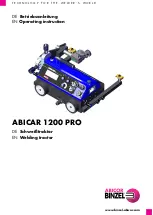
B-7
OPERATION
B-7
CONSTANT CURRENT OPERATION WITH
A LINCOLN ELECTRIC WIRE FEEDER
Lincoln Electric does NOT recommend constant
current semiautomatic welding for applications
which need to meet specified weld metal chemical
or mechanical property requirements or weld
quality requirements.
-------------------------------------------------------------
Most semiautomatic welding processes perform bet-
ter using constant voltage power sources. Welding
codes usually do not address the power source
selection or specifically, whether the welding process
is to be operated in the constant voltage or constant
current mode. Instead, codes typically specify limita-
tions on the current, voltage, heat input and preheat
temperature based on the material to be welded. The
intention is to assure that proper weld material prop-
erties will develop. Welding is sometimes performed
using constant current power sources. The operation
can be more convenient because it may allow the use
of an existing stick (SMAW) power source and the
power source can be placed at a distant location
without any provision for adjusting the output set-
tings.
For constant current operation, the power source is
set to deliver the specified current. The power source
regulates this current regardless of changes in the
welding circuit, including cable length, electrode
diameter, wire feed speed, contact tip to work dis-
tance, etc.
Changes in the wire feed speed (WFS) or contact tip
to work distance (CTWD) affect the arc voltage when
constant current power sources are used. Lowering
the wire feed speed raises the voltage, raising the
wire feed speed lowers the voltage. Lengthening the
contact tip to work distance raises the voltage, short-
ening the contact tip to work distance lowers the volt-
age. If the contact tip to work distance is properly
maintained, a satisfactory operating voltage range
may be achieved, and a sound weld may result.
However, when a welder uses a longer contact tip to
work distance, an arc-sensing wire feeder compen-
sates by increasing the wire feed speed to regulate
the voltage.
Even if the voltage and current remain unchanged,
the increased wire feed speed may result in a deposi-
tion rate well beyond the specified range of the elec-
trode. Under these conditions, the specified weld
metal properties may not be achieved. Constant volt-
age power sources deliver large current surges to
stabilize the arc when the electrode is shorted or the
arc length is very short.
However, a constant current power source does not
provide such a response to stabilize the arc. It may
be difficult to achieve required weld metal properties,
or to achieve the required quality of welds needed to
pass nondestructive tests, when such welds are
made under constant current operation.
BIG RED™ 600
Summary of Contents for BIG RED 600
Page 33: ...F 1 DIAGRAMS F 1 BIG RED 600 ...
Page 34: ...F 2 DIAGRAMS F 2 ...
Page 37: ...F 5 DIAGRAMS F 5 BIG RED 600 ...
















































